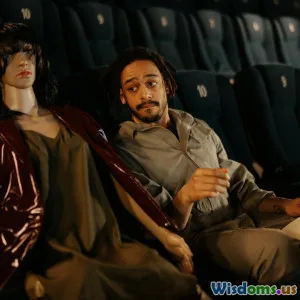
The Evolution of Cinema: A Cultural Perspective
8 min read Explore how cinema has transformed over time, shaping and reflecting cultural identities and societal shifts across the globe. (0 Reviews)
The Evolution of Cinema: A Cultural Perspective
Cinema is more than just entertainment; it is a mirror reflecting the evolving tapestry of human culture. From the flickering silent images of the late 19th century to today's immersive digital epics, films have continually reshaped and been shaped by the societies that produce and consume them. This article takes you on a journey through the evolution of cinema, emphasizing its deep cultural significance and how it remains a powerful medium through which societies express identities, struggles, dreams, and transformations.
Introduction: Cinema as a Cultural Artifact
Imagine sitting in a dimly lit theater in 1895, watching the Lumière brothers’ first short films — mere moments in time captured on celluloid, yet revolutionary in their promise. Cinema instantly transcended being a technological novelty; it became a platform where shared human experiences were dramatized and disseminated.
Film, uniquely, is a collaborative art form blending narrative, visual arts, music, and performance, making it a potent cultural artifact. It records societal values and challenges prevailing notions, often influencing global perceptions. As historian Robert Sklar noted, "Cinema bridges the individual and society, culture and commerce, art and technology."
As we explore cinema’s evolution, consider how these changes are consistently intertwined not just with technological advances but with shifting cultural landscapes that shape the stories we tell and how audiences engage with them.
Early Cinema: The Birth of Visual Storytelling
The late 1800s introduced cinema with devices like the kinetoscope and later the cinematograph. Early films were short, simple scenes reflecting daily life or vaudeville acts. Yet, even then, filmmakers sensed cinema’s potential storytelling power.
Silent Film Era and Cultural Reflection
Between 1895 and the late 1920s, movies were silent and relied heavily on physical acting, title cards, and musical accompaniment. This era birthed many film genres—comedy, tragedy, melodrama—rooted in theatrical traditions but refined by cinematic innovation.
Important cultural phenomena are evident here. For example, German Expressionist cinema, exemplified by The Cabinet of Dr. Caligari (1920), mirrored the tense sociopolitical atmosphere of post-World War I Germany through its distorted visuals and shadow play.
Meanwhile, Hollywood's rise reflected American industrialization and optimism, creating the “star system,” where actors like Charlie Chaplin embodied working-class ethos and universal humor amid economic hardships.
The Golden Age of Hollywood and Global Narratives
From the 1930s to the 1950s, often called the Golden Age of Hollywood, cinema blossomed into a major industry with influential studios, advanced technical standards, and storytelling sophistication.
National Identities Through Film
During this period, different countries used cinema to craft and promote national identities. Italy’s Neorealism, emerging after World War II with films like Bicycle Thieves (1948), portrayed the stark realities of everyday Italians, countering Hollywood’s glitz and offering a mournful, poetic reflection of societal hardship.
Similarly, the Soviet Union exploited cinema for propaganda with directors like Sergei Eisenstein, whose montage techniques in Battleship Potemkin (1925) combined artistry and political messaging to inspire revolutionary ideals.
The American Dream and Cultural Export
Hollywood’s dominance cemented American cultural ideals worldwide, exporting not just films but ideologies about opportunity and individualism — shaping global perceptions during the Cold War. The rise of color films and Technicolor enhanced the spectacle, perfect for mass appeal.
Modern Cinema: From New Waves to Digital Frontiers
The post-1960s era introduced various “New Wave” movements — French, Japanese, Indian, and others — each reimagining film language to critique societal norms and push aesthetic boundaries.
Cultural Critique and Innovation
For instance, Japan’s New Wave challenged traditional narrative forms, reflecting cultural shifts and post-war realities. Directors like Akira Kurosawa melded Japanese and Western storytelling to achieve global resonance, as in Seven Samurai (1954).
In India, parallel cinema offered a counterpoint to Bollywood’s escapism, tackling social issues with films like Pather Panchali (1955), which gained international acclaim and spotlighted rural Indian life.
Digital Revolution and Globalization
Advancements in CGI and digital filmmaking democratized cinema production and distribution, enabling more voices from diverse cultures to be heard. Global platforms like Netflix now showcase international cinema to vast audiences, breaking down traditional cultural and linguistic barriers.
Movies such as South Korea’s Parasite (2019), the first non-English film to win the Academy Award for Best Picture, highlight cross-cultural appeal and narrative universality.
Cinema and Cultural Identity: A Reciprocal Relationship
Cinema does not simply depict culture — it interacts with and often shapes it. Films contribute to cultural memory, identity formation, and social discourse.
Representation and Inclusivity
Growing demands for diverse representation emphasize cinema’s role in reflecting societal demographics and narratives long marginalized. The success of movies like Black Panther (2018) demonstrates the cultural and economic impact of stories centered on underrepresented communities, igniting conversations about identity and empowerment globally.
Social Movements and Film
Films have historically mirrored or even fueled social change movements. The Civil Rights era produced documentaries and narratives that highlighted systemic racism and inspired activism. More recently, social issues such as gender equality and climate change find resonance in film festivals, indie productions, and mainstream cinema alike.
Conclusion: Cinema as a Catalyst for Cultural Dialogue
The evolution of cinema is a story of continuous conversation between art, technology, and society. From its beginnings as moving pictures to fully immersive experiences, cinema remains a vital cultural force — one that documents, critiques, and shapes human experience in profound ways.
Understanding cinema’s development through a cultural lens enriches our appreciation of films not just as entertainment but as meaningful reflections of who we are. As cinematic technologies evolve and societies become more interconnected, that dialogue will only deepen.
In an era flooded with content, the best cinema continues to be that which resonates culturally, sparks thought, and fosters mutual understanding across the diverse human story.
“The movies are a mirror reflecting the cultural consciousness of the age we live in.” - Martin Scorsese
Rate the Post
User Reviews
Popular Posts



















